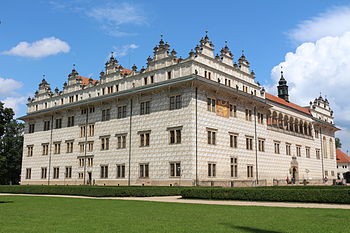Litomyšl Castle
The Litomyšl Castle (German: Leitomischl ) in the eastern Bohemian town of Litomyšl in Okres Svitavy is one of the most important Renaissance -Historical sites in the Czech Republic .
history
The chateau was probably built on the site of a Slavic fort that the Slavnikids are said to have built in the 10th century and which belonged to the Kostka von Postupice estate after 1432 . After Bohuš von Postupice had supported the uprising against King Ferdinand I in 1547 , Litomyšl was lost to the Postupice family. The new owner of the Litomyšl rule was the Bohemian Chancellor Vratislav von Pernstein , who had the renaissance castle built by Giovanni Battista Aostalli and Ulrico Aostalli in 1568–1581 . After 1631 with Vratislav Pernstein Eusebius of the Pernstein in the male line extinguished, it inherited his sister Frebonie , which in 1646 her cousin Wenzel Eusebius of Lobkowicz inherited. From 1649 it belonged to the aristocratic Trauttmansdorff family , who had the castle redesigned in the first half of the 18th century by Franz Maximilian Kaňka in the classicist Baroque style. In 1758 the Counts Waldstein acquired it . Georg Josef von Waldstein-Wartenberg arranged for the palace theater to be built. The last owners were the Princes of Thurn und Taxis , who acquired the castle in 1855.
The composer Bedřich Smetana , born in Litomyšl in 1824 as the son of a brewer, made his first public appearance as a pianist in the castle theater.
After the Second World War , the castle was nationalized and declared a national cultural monument in 1962 . The Smetanová Litomyšl Opera Festival has been held in the chateau since 1949 . At the invitation of the then President Václav Havel , a meeting of seven Central European Presidents took place in the castle in 1994. The entire palace area, which has been extensively renovated in recent years, has been a UNESCO World Heritage Site since 1999, and it was included in the list .
Exterior design
The sgraffito on the rustication -Außenwänden created Šimon Vlach. The largely uniform facade is adorned with different Renaissance gables and the south wing on the third floor is interrupted by nine arcades. The main portal is decorated with the Pernstein coat of arms, which depicts an aurochs with a nose ring.
The inner courtyard is surrounded on three sides by a three- story arcade and the north wall is adorned with chiaroscuro decorations of ancient and biblical scenes.
Attractions
- The reconstructed living quarters of the castle are furnished with precious paintings and furniture.
- The palace chapel , consecrated to St. Michael , with the three large windows on the south side of the facade, dates from the time it was built.
- The Battle Hall , Count Trauttmansdorff 1730 with scenes of the battles of the Prince Eugene of Savoy decorate.
- The palace theater on the ground floor of the west wing was built between 1796 and 1797 and was painted by Dominik Dvořák. It is one of the oldest still preserved theaters in Central Europe and has the original sets and decorations by Joseph Platzer .
- FM Kaňka built the stables east of the castle in 1725. The Roßlenker sculpture was made by Matthias Bernhard Braun .
- Opposite the castle is the building of the former castle brewery . It was converted to Baroque style by FM Kaňka in 1730 and is the birthplace of the composer Bedřich Smetana .
- The chateau park was transformed into a baroque complex by FM Kaňka in 1726. At the end of the 18th century, a pavilion was built in the park and painted with scenes from ancient Egypt.
literature
- Erhard Gorys : DuMont art travel guide Czech Republic. Culture, landscape and history in Bohemia and Moravia. DuMont, Cologne 1994, ISBN 3-7701-2844-3 .
- Marianne Mehling: Knaur's Art Guide Czech Republic . ISBN 3-426-26609-1
- Joachim Bahlcke , Winfried Eberhard, Miloslav Polívka (eds.): Handbook of historical places . Volume: Bohemia and Moravia (= Kröner's pocket edition . Volume 329). Kröner, Stuttgart 1998, ISBN 3-520-32901-8 , pp. 330-332.
Web links
Coordinates: 49 ° 52 ′ 25 ″ N , 16 ° 18 ′ 52 ″ E





